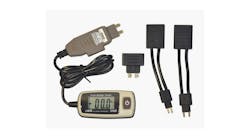For any facility maintaining and repairing vehicles, vehicle lifting equipment is imperative to efficient operations. There are a number of vehicle lift options for shops – whether that be heavy duty equipment and trucking facilities or light duty repair shops.
When it comes to choosing the most appropriate vehicle lifts for a maintenance or repair facility, Dr. Jean Dellamore, President, Stertil-Koni USA, says there are three aspects to consider:
- The type of vehicles serviced.
- The most common maintenance and service work performed.
- Shop budget.
According to ALI (Automotive Lift Institute), common lift types are grouped into the following seven categories:
- Two-post surface mounted lifts.
- Multi-post runway lifts.
- Low/mid-rise frame engaging lifts.
- Drive-on parallelogram lifts.
- Scissor lifts.
- In-ground lifts.
- Mobile column lifts.
Two-Post Lifts
Two-post surface-mounted lifts are the most popular type of lift used today, says ALI.
Two-post lifts are typically frame-engaging and have above-ground swing arms which travel up the two columns to lift the vehicle. A variety of accessories and adapters are available to allow for different functions, such as wheel-engaging operation.
Two-post lifts are most often used for general maintenance on light and medium duty vehicles. This lift type is a versatile option for many shops, allowing full access underneath the vehicle.
Multi-Post Runway Lifts
Most commonly configured as a four-post surface-mounted lift, multi-post runway lifts allow the vehicle to be driven onto two runways and lifted by its tires, providing full access to the underside of the vehicle, ALI says.
“Four post lifts offer very low drive on-height and are ideal for low-ground clearance vehicles,” says Stertil-Koni’s Dellamore.
Four-post lifts can also be configured to perform wheels-free services.
This lift type is used primarily for quick preventative maintenance and inspections.
In addition to common use for light duty vehicle work, he adds the these types of lifts can also be used to service a variety of commercial vehicles, including three-wheel forklift trucks, vans, articulated buses, construction trucks, utility vehicles and other heavy duty vehicles.
Low- or Mid-Rise Frame-Engaging Lifts
Low and mid-rise frame or body engaging lifts usually engage the vehicle’s frame or its perimeter. The lift operates in either a traditional parallelogram-style, which moves fore or aft as it lifts and lowers, or a scissors-style, which moves in a straight vertical direction, says ALI.
These lifts may be powered by an electric-hydraulic power unit. Or, in the case of some low-rise service lifts, they can be powered by compressed air.
Keep in mind there is limited access to the underside of a raised vehicle on this lift type, advises ALI.
Parallelogram Lifts
Most parallelogram lifts are drive-on lifts with two runways. Traditional parallelogram lifting mechanisms move the vehicle a short distance fore or aft when lifting or lowering.
There are some hybrid versions of this lift type that move straight up and down.
This lift type is powered by an electro-hydraulic power unit. Synchronization of the two parallel runways is usually accomplished by hydraulic or electronic means. Sometimes a torsion bar connected to opposing parallelogram legs is employed to assist in synchronization.
Some drive-on parallelogram lifts can be configured to perform wheels-free services.
Scissors Lifts
The scissors lift may be equipped as a drive-on style with runways, or as a lift that is frame- or body-engaging.
The scissors lift has a lifting mechanism similar to a traditional parallelogram lift, however, it lifts and lowers a vehicle in a straight vertical path, rather than fore or aft of its original position, ALI says.
The benefits of this lift are numerous, according to Stertil-Koni’s Dellamore, and can include wheels-free lifting, an ultra-shallow pit design, an ideal lift design for retrofitting into existing workshops, a free-standing console for quick service access and continuous recess for maximum flexibility.
Specifically in the case of heavy duty vehicles, a scissors lift is suitable for servicing articulated buses, fire and rescue vehicles, multiple-axle trucks, school and transit buses, to name a few.
In-Ground Lifts
Lifts with lifting assemblies installed below the garage floor are known as in-ground lifts.
Most modern manufacturers of in-ground lifts have developed systems to contain all of the hydraulic components within an enclosure. This reduces the risk of soil contamination from hydraulic leaks, says ALI.
These lifts employ one or more hydraulic pistons or scissors mechanisms, depending on the type of vehicle and how much weight is to be lifted. Light duty lifts use one or two pistons. Heavy duty in-ground lifts feature two to three pistons or scissors mechanisms.
Different in-ground lifts are manufactured to suit almost any type of repair or maintenance service on virtually any vehicle.
In addition, in-ground lifts provide wheels-free access to the vehicle and are ideal for shops with low ceilings.
Also, from a safety perspective, in-ground lift floor covers are flush, preventing tripping hazards and tools from dropping into the pit.
Wheel-Engaging Mobile Columns
Commonly referred to as a mobile column lift, wheel-engaging mobile columns are used in sets of two, four, six or more units. Each of the individual columns is mobile, contains an electric power unit and is operated by a hydraulic cylinder or screw drive, says ALI. The columns communicate wirelessly, or through cables, to enable synchronized operation to lift and lower a vehicle.
This popular lift type requires a hard, level surface and can be moved as needed to lift the vehicle, ALI says.
Mobile columns can be positioned and operated by one technician. While they can be used for light duty vehicles, mobile column lifts are more readily seen in heavy duty facilities.
This type of lifting equipment is used for a variety of vehicles, including articulated buses; Class 8 trucks; forklifts; agricultural equipment; military, industrial and utility vehicles; and more.
Information in this article was organized with the help of ALI (www.autolift.org) and Steril-Koni (stertil-koni.com).

